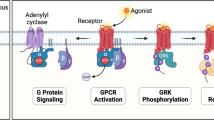Conclusion
A variety of mechanisms are used by individual cells to modulate the response of specific genes to steroid hormones. In addition to the classical presence or absence of a steroid nuclear receptor, there are several mechanisms for determining tissue specificity: (i) changes in the receptor structure induced by different ligands, (ii) the role of specific transcription factors, (iii) the presence of alternate steroid hormone DNA binding sites which preferentially interact with some but not all members of a particular class, and (iv) the presence of extra receptor enzyme systems which can modify the steroid before it can interact with its nuclear receptor. All these mechanisms participate in turning a potentially homogeneous response system into a very heterogeneous one with a high degree of tissue and substrate specificity. Most of these mechanisms are involved in modifying the reponse of an individual tissue to estrogen agonists and antagonists.
Similar content being viewed by others
References
Karas RH, Patterson BL, Mendelsohn ME. Human vascular smooth muscle cells contain functional estrogen receptor. Circulation 1994;89:1943–50.
Losordo DW, Kearney M, Kim EA, et al. Variable expression of the estrogen receptor in normal and atherosclerotic coronary arteries of premenopausal women. Circulation 1994;89:1501–10.
Yang NN, Bryant HU, Hardikar S, et al. Estrogen and raloxifene stimulate transforming growth factor-beta 3 gene expression in rat bone: a potential mechanism for estrogen-or raloxifene-mediated bone maintenance. Endocrinology 1996;137:2075–84.
Kuiper GG, Brinkmann AO. Steroid hormone receptor phosphorylation: is there a physiological role? Mol Cell Endocrinol 1994;100:103–7.
Ince BA, Montano MM, Katzenellenbogen BS. Activation of transcriptionally inactive human estrogen receptors by cyclic adenosine 3′, 5′-monophosphate and ligands including anti-estrogens. Mol Endocrinol 1994;8:1397–406.
Elliston JF, Katzenellenbogen BS. Comparative analysis of estrogen receptors covalently labeled with an estrogen and an anti-estrogen in several estrogen target cells as studied by limited proteolysis. J Steroid Biochem 1988;29:559–69.
Pakdel F, Katzenellenbogen BS. Human estrogen receptor mutants with altered estrogen and anti-estrogen ligand discrimination. J Biol Chem 1992;267:3429–37.
Katzenellenbogen BS, Bhardwaj B, Fang H, et al. Hormone binding and transcription activation by estrogen receptors: analyses using mammalian and yeast systems. J Steroid Biochem Mol Biol 1993;47:39–48.
Parker MG, Arbuckle N, Dauvois S, et al. Structure and function of the estrogen receptor. Ann N Y Acad Sci 1993;684:119–26.
McDonnell DP, Clemm DL, Hermann T, et al. Analysis of estrogen receptor function in vitro reveals three distinct classes of anti-estrogens. Mol Endocrinol 1995;9:659–69.
Diamond MI, Miner JN, Yoshinaga SK and Yamamoto KR. Transcription factor interactions: selectors of positive or negative regulation from a single DNA element. Science 1990 ;249:1266–72.
Pearce D, Yamamoto KR. Mineralocorticoid and glucocorticoid receptor activities distinguished by non-receptor factors at a composite response element. Science 1993;259:1161–5.
Webb P, Lopez GN, Uht RM, et al. Tamoxifen activation of the estrogen receptor/AP-1 pathway: potential origin of the cell-specific estrogen-like effects of anti-estrogens. Mol Endocrinol 1995;9:443–56.
Kraus WL, McInerney EM, Katzenellenbogen BS. Ligand-dependent, transcriptionally productive association of the amino- and carboxyl-terminal regions of a steroid hormone nuclear receptor. Proc Natl Acad Sci USA1995;92:12314–8.
McDonnell DP, Dana SL, Hoener PA, et al. Cellular mechanisms which distinguish between hormone- and antihormone-activated estrogen receptor. Ann N Y Acad Sci 1995;761:121–37.
Funder JW. Mineralocorticoids, glucocorticoids, receptors and response elements. Science 1993;259:1132–3.
Kraus WL, Weis KE, Katzenellenbogen BS. Inhibitory cross-talk between steroid hormone receptors: differential targeting of estrogen receptor in the repression of its transcriptional activity by agonist- and antagonist-occupied progestin receptors. Mol Cell Biol 1995;15:1847–57.
Kuiper GG, Enmark E, Pelto-Huikko M, et al. Cloning of a novel receptor expressed in rat prostate and ovary. Proc Natl Acad Sci USA 1996;93:5925–30.
Yang NN, Venugopalan M, Hardikar S, et al. Identification of an estrogen response element activated by metabolites of 17β-estradiol and raloxifene. Science 1996;273:1222–5.
Edwards CRW, Stewart PM, Burt DB, et al. Localization of 11-β-hydroxysteroid dehydrogenase tissue-specific protector of the mineralocorticoid receptor. Lancet 1988;2:986–9.
Williams GH. Guardian of the gate: receptors, enzymes, and mineralocorticoid function. J Clin Endocrinol Metab 1992;74:961–2.
Author information
Authors and Affiliations
Rights and permissions
About this article
Cite this article
Williams, G.H. Steroid receptor specificity with reference to the estrogen receptor. Osteoporosis Int 7 (Suppl 1), 35–39 (1997). https://doi.org/10.1007/BF01674811
Issue Date:
DOI: https://doi.org/10.1007/BF01674811




